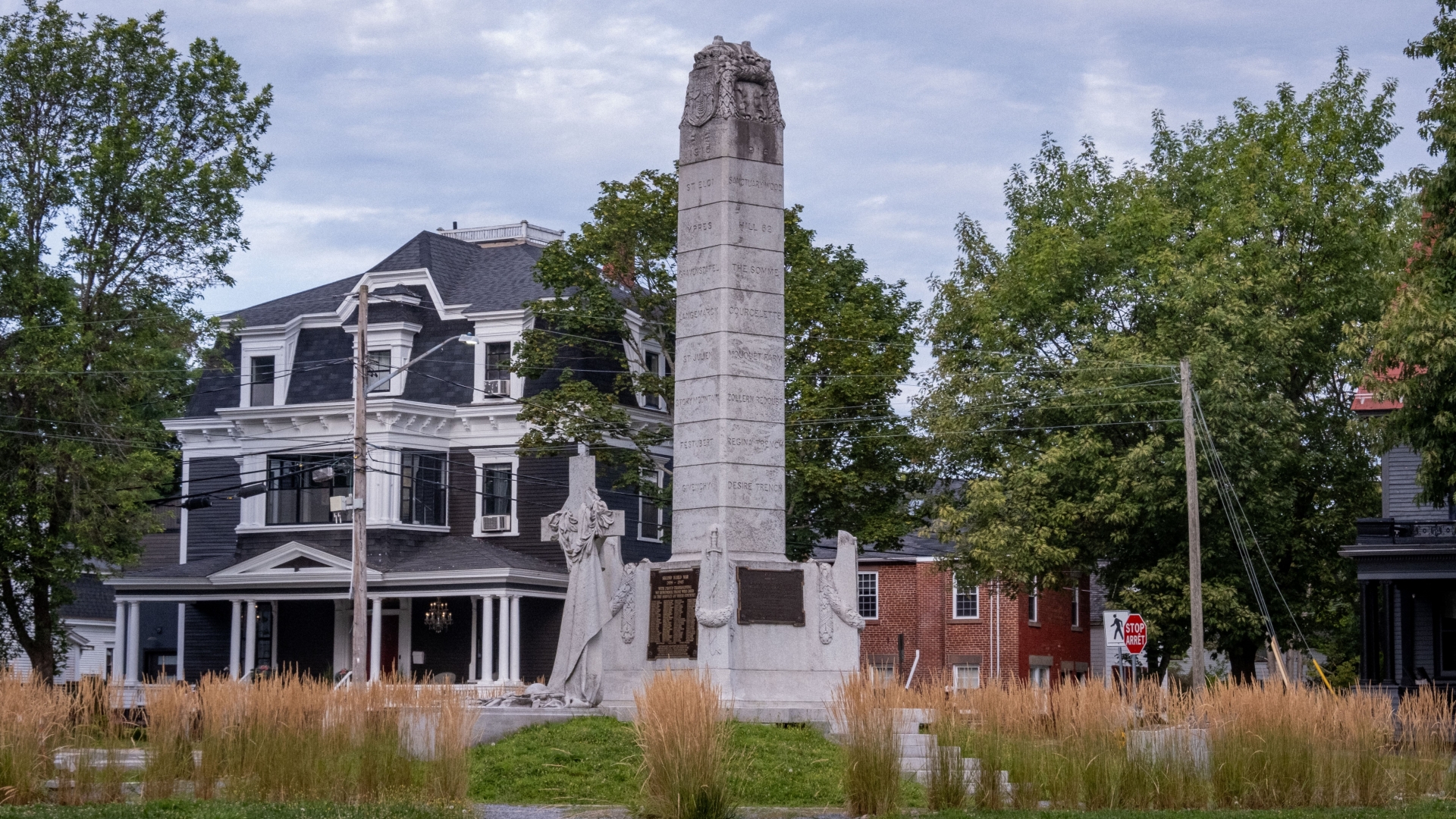Fredericton’s War Memorial, the Cenotaph, is located on the triangular green at the intersection of Queen, Church, and King Streets.
Heritage Value
The Cenotaph stands in recognition of Fredericton’s fallen soldiers. Originally erected to memorialize the citizen soldiers who lost their lives during World War I, the Cenotaph also honours the casualties of other conflicts, including World War II and the Korean War.
Discussion of a war memorial began in 1921 under the auspices of the Great War Veterans’ Association. Mr. Oswald S. Crocket, Justice of the Supreme Court of New Brunswick, served as Chairman of the War Memorial Committee. In 1922, the Committee began gathering soldiers’ names for the memorial tablet to be placed on the monument, and the difficulties of completing this list delayed the unveiling in 1923. Upon the bronze tablet, 109 names have been inscribed, memorializing the First World War soldiers.
The War Memorial Committee engaged the Toronto firm, Thompson Monument Company to cut and install the 25-foot-tall white granite monument. The towering monument stands upon a 26-ton granite die, and at the time was reportedly the largest block of cut granite in Canada. Inscribed on the sides of the shaft are the
names of the WWI battles in which Fredericton soldiers lost their lives. The capstone, surmounting the 14-foot shaft of the monument, has been engraved with the coat of arms of Fredericton on the front and that of the Province of New Brunswick on the rear. In front of the monument stands the Cenotaph, an empty tomb surmounted with a carving of rifle, side arms, and shell helmet. A large granite cross overlooks the tomb.
The War Memorial was originally intended to be unveiled in July 1923 to coincide with the Governor General’s visit, but with the list of soldiers not yet complete, the ceremony was postponed until August, in honour of the Battle of Amiens. Finally, it was decided to unveil the monument on the fifth anniversary of the signing of the armistice, November 11, 1923.
The unveiling was occasioned by great ceremony, with Sir John Douglas Hazen, former Mayor of Fredericton and Premier of New Brunswick, delivering the dedicatory address. Miss Marjorie Osborne, daughter of Lieutenant Colonel W.J. Osborne and sister of Hubert, one of the soldiers listed on the tablet, pulled the cord, releasing the Union Jack from the memorial. In subsequent years, other memorial tablets have been added to the monument, honouring those who served their country.
The Fredericton Cenotaph has the distinction of being designated as a Provincial Cenotaph, the first in Canada. The Fredericton Cenotaph was recognized as the Provincial Cenotaph on October 18, 2007.
Character-Defining Elements
The character-defining elements associated with the Cenotaph include:
-
White granite material
-
Location upon a prominent triangular green at the junction of King, Queen, and Church Streets
-
Large carved granite die surmounted by a vertical carved granite obelisk monument, engraved with names of 32 battles fought during World War I and topped with a capstone bearing Fredericton and Provincial Coats of Arms
-
Bronze memorial tablet bearing names of fallen World War I soldiers, front of monument
-
memorial tablet bearing names of fallen World War Two soldiers, rear of monument
-
memorial tablet dedicated to Merchant Marines, south facing side of monument
-
memorial tablet bearing names of fallen Korean War soldiers, north facing side of monument
-
Granite Cenotaph, with carved rifle, side arms, and shell helmet carvings
-
Granite draped cross at head of Cenotaph
-
Memorialization of Fredericton’s fallen citizen soldiers
-
Symbolic significance in the community, honoured every Remembrance Day


